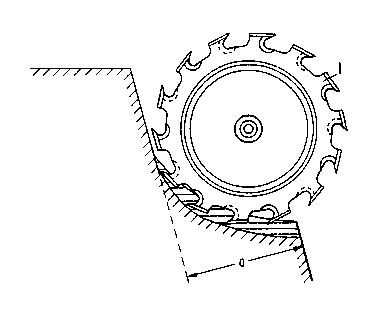Some of the information on this Web page has been provided by external sources. The Government of Canada is not responsible for the accuracy, reliability or currency of the information supplied by external sources. Users wishing to rely upon this information should consult directly with the source of the information. Content provided by external sources is not subject to official languages, privacy and accessibility requirements.
Any discrepancies in the text and image of the Claims and Abstract are due to differing posting times. Text of the Claims and Abstract are posted:
| (12) Patent: | (11) CA 2112813 |
|---|---|
| (54) English Title: | ROTARY CUTTER FOR EXTRACTING HARD ROCK |
| (54) French Title: | FRAISE ROTATIVE POUR L'EXTRACTION DE ROCHES DURES |
| Status: | Expired and beyond the Period of Reversal |
| (51) International Patent Classification (IPC): |
|
|---|---|
| (72) Inventors : |
|
| (73) Owners : |
|
| (71) Applicants : |
|
| (74) Agent: | MACRAE & CO. |
| (74) Associate agent: | |
| (45) Issued: | 2000-06-13 |
| (86) PCT Filing Date: | 1992-06-23 |
| (87) Open to Public Inspection: | 1993-01-21 |
| Examination requested: | 1994-06-07 |
| Availability of licence: | N/A |
| Dedicated to the Public: | N/A |
| (25) Language of filing: | English |
| Patent Cooperation Treaty (PCT): | Yes |
|---|---|
| (86) PCT Filing Number: | PCT/EP1992/001410 |
| (87) International Publication Number: | WO 1993001392 |
| (85) National Entry: | 1994-01-04 |
| (30) Application Priority Data: | ||||||
|---|---|---|---|---|---|---|
|
Proposed is the use of a wheel-shaped
rotary cutter for the continuous working of hard
mineral-rock beds with a cylinder crushing resistance
of greater than or equal to 20 MPa, the
cutter being fitted both round its circumference
and at the sides with a multiplicity of cutting
elements. The cutter is driven to operate in the
vertical plane, powered by a generator with an
installed rating of at least 0,3 kW per theoretically
calculated cubic meter of rock extracted
per hour.
Il est proposé l'utilisation d'un outil de fraisage à disque pour l'extraction en continu de couches de roche minérales dures avec une résistance à l'écrasement cylindrique supérieure ou égale à 20 MPa, l'outil de fraisage étant muni tant sur sa circonférence que sur ses faces frontales d'une pluralité d'éléments de coupe. L'outil de fraisage est utilisé en trait d'abattage, en coopération avec un équipement moteur présentant une puissance installée d'au moins 0,3 kW par m3/h de puissance d'extraction théorique.
Note: Claims are shown in the official language in which they were submitted.
Note: Descriptions are shown in the official language in which they were submitted.

2024-08-01:As part of the Next Generation Patents (NGP) transition, the Canadian Patents Database (CPD) now contains a more detailed Event History, which replicates the Event Log of our new back-office solution.
Please note that "Inactive:" events refers to events no longer in use in our new back-office solution.
For a clearer understanding of the status of the application/patent presented on this page, the site Disclaimer , as well as the definitions for Patent , Event History , Maintenance Fee and Payment History should be consulted.
| Description | Date |
|---|---|
| Time Limit for Reversal Expired | 2007-06-26 |
| Letter Sent | 2006-06-23 |
| Inactive: Cover page published | 2001-09-05 |
| Inactive: Acknowledgment of s.8 Act correction | 2000-07-21 |
| Inactive: Cover page published | 2000-07-21 |
| Inactive: Prior art correction | 2000-07-21 |
| Inactive: S.8 Act correction requested | 2000-07-13 |
| Grant by Issuance | 2000-06-13 |
| Inactive: Cover page published | 2000-06-12 |
| Inactive: Status info is complete as of Log entry date | 2000-03-27 |
| Inactive: Application prosecuted on TS as of Log entry date | 2000-03-27 |
| Inactive: Final fee received | 2000-03-13 |
| Pre-grant | 2000-03-13 |
| Letter Sent | 2000-01-11 |
| Notice of Allowance is Issued | 2000-01-11 |
| Notice of Allowance is Issued | 2000-01-11 |
| Inactive: Approved for allowance (AFA) | 1999-12-08 |
| Inactive: Multiple transfers | 1999-02-17 |
| All Requirements for Examination Determined Compliant | 1994-06-07 |
| Request for Examination Requirements Determined Compliant | 1994-06-07 |
| Application Published (Open to Public Inspection) | 1993-01-21 |
There is no abandonment history.
The last payment was received on 1999-05-27
Note : If the full payment has not been received on or before the date indicated, a further fee may be required which may be one of the following
Please refer to the CIPO Patent Fees web page to see all current fee amounts.
| Fee Type | Anniversary Year | Due Date | Paid Date |
|---|---|---|---|
| MF (application, 5th anniv.) - standard | 05 | 1997-06-23 | 1997-05-26 |
| MF (application, 6th anniv.) - standard | 06 | 1998-06-23 | 1998-05-21 |
| Registration of a document | 1999-02-17 | ||
| MF (application, 7th anniv.) - standard | 07 | 1999-06-23 | 1999-05-27 |
| Final fee - standard | 2000-03-13 | ||
| MF (patent, 8th anniv.) - standard | 2000-06-23 | 2000-06-13 | |
| MF (patent, 9th anniv.) - standard | 2001-06-25 | 2001-05-28 | |
| MF (patent, 10th anniv.) - standard | 2002-06-24 | 2002-05-17 | |
| MF (patent, 11th anniv.) - standard | 2003-06-23 | 2003-05-20 | |
| MF (patent, 12th anniv.) - standard | 2004-06-23 | 2004-05-26 | |
| MF (patent, 13th anniv.) - standard | 2005-06-23 | 2005-05-27 |
Note: Records showing the ownership history in alphabetical order.
| Current Owners on Record |
|---|
| KRUPP FORDERTECHNIK GMBH |
| Past Owners on Record |
|---|
| JOACHIM METT |
| WOLFGANG FLEISCHHAKER |